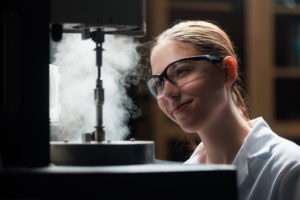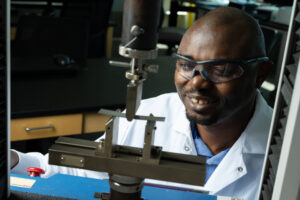Design Projects for Student Teams
The goal of the senior design projects is to provide materials science and engineering undergraduates with a practical and realistic senior design experience so they become career-ready engineers. The department has developed a program by which senior students work closely with industry leaders on real materials problems.
The objective of this design course is not only to learn and practice the methods of engineering design, but also to carry through with synthesis, testing and evaluation. This experience often provides students with their first opportunity to work with engineers in industry.
Engineers and managers in industry have the opportunity to contribute directly to the formal education of engineers and give suggestions about the content of design courses.
Course Structure
MAT E 413/414 is a two-semester course in which materials engineering students work on industry sponsored projects. Offered in both the fall and spring semesters, students begin by learning the fundamentals of engineering design and materials selection before teaming to address a real-world design problem. Working with a faculty mentor and project sponsors, teams collaborate to define the customer needs, consider constraints, develop and implement potential design solutions and test and evaluate the results. The projects culminate in a final written and oral report presented to faculty, industry sponsors, and peers. Some projects start in mid-October and end in early May and others start in mid-March and end in early December.
Potential Projects
A successful project doesn’t always involve making something, though it might. A potential project could involve designing a new material or process or evaluating an existing one.
When evaluating a potential project, please consider the following:
- Projects should be relevant to the company.
- Projects should include a set of long-range objectives as well as a set of clear short-term objectives that are achievable by students within the project timeframe.
- Each project needs the industrial partner to provide the student group with project objectives and criteria for success.
What is Involved?
In addition to a project description that highlights key objectives, constraints, and metrics for success, companies are asked to provide the following:
- Financial Commitment: Companies are asked to pay $1,000 to be billed through Iowa State Accounts Receivable when Sponsor Acknowledge Form is agreed and signed. Any costs over $1,000 would have to be approved first by the company via written documentation with Senior Design project team and Instructor. The amount over $1,000 will be billed at the end of the semester.
- Resources: This may include samples, supplies, or specialized equipment. An engineer within the company should be assigned as a primary point of contact for the team. Student travel to the company and/or having company personnel visit Iowa State should also be considered. It is important for the company to commit an individual or individuals who are knowledgeable about the project and have the time to serve as an industry mentor for the student group.
- Outcomes: In addition to the project objectives, this may include items such as reports/analyses, prototypes, models, software, data, etc.
- Confidential Information and/or Intellectual Property agreements: While it is the University’s preference that sponsors make a reasonable effort to avoid the inclusion of confidential information in these projects, there is a Non-Disclosure Agreement form available in cases where this isn’t possible. While the University encourages sponsors to permit students to retain their intellectual property rights, there is a Special Intellectual Property Agreement form available to permit the sponsor to obtain ownership rights.
Benefits to Companies
The benefits to participating companies could include:
- Student teams providing insights into existing problems.
- Expertise and specialized knowledge offered by faculty and students
- Exploring new concepts and processes through a low-cost, low-risk investigation.
- Engaging with students as potential employees; evaluating their technical and interpersonal skills.
- Gaining exposure on campus as senior students are considering employment opportunities.
- Having access to equipment and expertise not available at their own site.
Benefits to Students
The benefits to participating students could include:
- Partnering with industry leaders to investigate important problems within a company
- Engaging with industry professionals who could be potential employers
- Participating in practical, innovative resolution strategies and design
- Gaining experience working with industry caliber equipment and techniques
- Receiving wisdom, advice, and feedback from faculty as well as mentors from partnering companies
- Exploring new concepts and processes through a low-cost, low-risk investigation
- Enhancing skills in collaboration, teamwork, presentations, technical writing and more
Examples of Design Project Abstracts
______________ sponsored a project to identify the cause and proposing solutions for inconsistent welds between nylon 6,6 33% glass filled and ePTFE. Historically, the sponsor has used ultrasonic and heat welding techniques to bond the two materials together creating venting solutions for a wide variety of market needs. However, these processes have limitations and impact the performance of the part. During this project, students will be asked to brainstorm new ways of attaching the materials, prototype the method, and quantify the impact of performance these methods have upon the ePTFE provided.
sponsored this senior design project to determine if low-temperature solid-state diffusion bonding of tin (Sn) and copper (Cu) for solder joints in electronic packaging was a potential method for high-reliability systems. Using the custom-made die-press and knowledge gained from training, the group completed testing and analysis

of the samples. Twenty-one samples were analyzed using a scanning electron microscope
(SEM); of which the samples that underwent heat treatment for longer periods of time under higher pressures had a larger percentage of bonding than those with lower parameters.
__________ sponsored this project to develop a method to remove gold from the intensifier solution used to weatherproof their product. The process must be safe. The solution exiting as waste should have less gold in it than it currently does. It is not necessary to extract elemental gold for reuse/sale from the process but it is desirable if cost effective.
Information for Companies
For more information and questions, contact Shraddha Vachhani.
